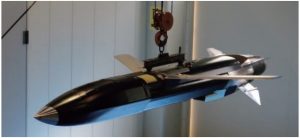On July 25, Japan’s Ground Self-Defense Force (JGSDF) Chief of Staff General Morishita Yasunori announced plans to build a firing range for surface-to-ship missile drills on Minamitorishima Island in the Pacific.
This will be the first launch range for a missile with a firing range of over 100 kilometers in Japan.
Minamitorishima Island is Japan’s easternmost island, located about 2,000 kilometers southeast of Honshu, largest of the four main islands of Japan. The remote island is already home to a Japan Maritime Self-Defense Force (JMSDF) base, and staff from the Japan Meteorological Agency are also stationed there on a permanent basis.
The island was apparently chosen because it has no regular residents and is off the route of commercial ships, making it easier to restrict the sea area when firing missiles. The launch site will utilize land to the west of the JMSDF base.
The plan came as the Japanese government is rushing to strengthen so-called counterstrike capabilities – meaning the ability to attack targets in enemy territory directly in an emergency. The Japanese government decided to acquire counterstrike capabilities in its National Security Strategy approved in December 2022, with China’s continued military expansion near the Japanese archipelago in mind.
Specifically, the JGSDF aims to set up a firing training range for its flagship Type 12 surface-to-ship missile (SSM) with a striking distance of about 200 kilometers. The missile is currently being upgraded to become the first Japan-made long-range cruise missile, which will have an extended range of some 1,000 kilometers.
Currently, the firing ranges in Japan can only handle shooting training for missiles with a range of about 40 kilometers. Accordingly, the JGSDF has conducted the firing training for the Type 12 guided missile at training ranges in the United States and Australia, which has limited the service’s training opportunities and the number of participating units.
“Having Japan’s own missile range will help maintain and improve our level of proficiency,” the JGSDF’s Chief of Staff Morishita said at a regular press conference on July 25.
The JGSDF is expected to begin operations at its training site on Minamitorishima Island after fiscal year 2026, and plans to use non-explosive training munitions against targets at sea tens to hundreds of kilometers away.
In December 2023, Japan’s Defense Minister Kihara Minoru announced that the JGSDF will deploy the land-based upgraded Type 12 SSM starting in its fiscal year 2025, which begins next April, a year earlier than originally planned.
Exercises using the improved Type 12 SSM will highly likely be carried out at the new training site on Minamitorishima Island.
Japan’s current stand-off missile capability is mainly focused on the upgraded Type 12 guided missile, which is the core of Japan’s counterattack ability.
Stand-off missiles allow a military to attack sites such as enemy missile bases from outside the enemy’s range.
In its latest defense white paper published on July 12, the Japanese Ministry of Defense unveiled a photo of the prototype of the improved Type 12 SSM. It appears similar to the Storm Shadow/SCALP EG, a Franco-British low-observable, long-range air-launched cruise missile. The Type 12 SSM is designed and built by Mitsubishi Heavy Industries.
The Defense Ministry has also brought forward the deployment of the U.S.-made Tomahawk cruise missiles with a range of over 1,600 kilometers to fiscal year 2025, one year earlier than originally planned.

































